WHEN to clamp the umbilical cord after birth has been the subject of much academic angst of late, but the authors of a Perspective published in the MJA this week suggest that baby knows best.
The first minute of life after birth is the critical moment when the newborn’s lungs transition from being liquid-filled to filling with air and taking over the role of gas exchange previously filled by the placenta via the umbilical cord.
Just when to cut the newborn off from that “back-up” supply of oxygen by clamping the cord has been analysed by two major articles in the past 3 months.
The Australian Placental Transfusion Study (APTS), published in the New England Journal of Medicine in December 2017, looked at delayed cord clamping (DCC) for 60 seconds after birth or before 10 seconds (immediate cord clamping) in infants born before 30 weeks’ gestation. The trial involving 1566 babies, the largest study of pre-term infants, didn’t reveal much difference between the two groups of babies, but there was a “tantalising” but non-significant reduction in hospital mortality.
The study prompted the authors to conduct a meta-analysis, published in the American Journal of Obstetrics and Gynaecology, which pooled their results with all the previous smaller trials done in pre-term infants. What they found was that for infants born at less than 28 weeks’ gestation there was a reduction in hospital mortality if cord clamping was delayed for 60 seconds compared with immediate cord clamping.
Associate Professor Graeme Polglase, from the Hudson Institute for Medical Research in Melbourne, said that the result was “the first real evidence for DCC in pre-term infants”.
“It showed not only that DCC was safe – there were no real adverse outcomes – but that there was also a potential benefit in terms of reduced mortality,” Associate Professor Polglase told MJA InSight in an exclusive podcast.
He and colleague Associate Professor Michael Stark, from the Women’s and Children’s Health Network in Adelaide, co-authored the MJA Perspective, in which they inject a note of caution into the APTS results.
“What we’re saying is there is a proviso. [The babies in the APTS] were relatively healthy pre-term infants and didn’t require intervention in terms of respiratory support,” he said.
“Ninety percent of [pre-term] babies require respiratory support.
“Clinical guidelines vary for DCC in pre-term infants from somewhere between 30 seconds to 3 minutes, but the reality is we just don’t know.
“One of the things that our research has focused on is not DCC by a set time, but allowing the baby to dictate when the umbilical cord should be clamped.
“The idea behind that is that when the baby is breathing and crying and moving vigorously, then that’s probably the time when the cord should be clamped. Delaying for a set time is counterproductive for pre-term infants.
“If the baby is at risk then by simply delaying cord clamping you’re delaying intervention, in this case respiratory support for pre-term infants.”
Personalised or precision medicine is the buzzword of the day and it’s a concept with which Associate Professor Polglase certainly agrees.
“We talk about personalised or precision medicine a lot and it certainly applies to babies whether pre-term or term,” he said
“The focus should be on treating the individual baby rather than treating all babies exactly the same. Currently, the resuscitation guidelines apply to every single baby born pre-term or term and you follow a set algorithm.
“We believe this is not a good idea, particularly in umbilical management. We should be allowing the baby to dictate when that cord should be clamped.”
To find a doctor, or a job, to use GP Desktop and Doctors Health, book and track your CPD, and buy textbooks and guidelines, visit doctorportal.

 more_vert
more_vert
How about a birth to an Rh negative mother? With 83% of our population being Rh positive, it is odds on that that baby will be Rh Positive. The biggest risk of feto-maternal transfusion causing maternal sensitisation occurs at the time of birth. C/S is a classic example, but a vaginal births also a risk factor. Early clamping of the cord in a Rh negative woman reduces significantly the chance of feto-maternal transfusion.